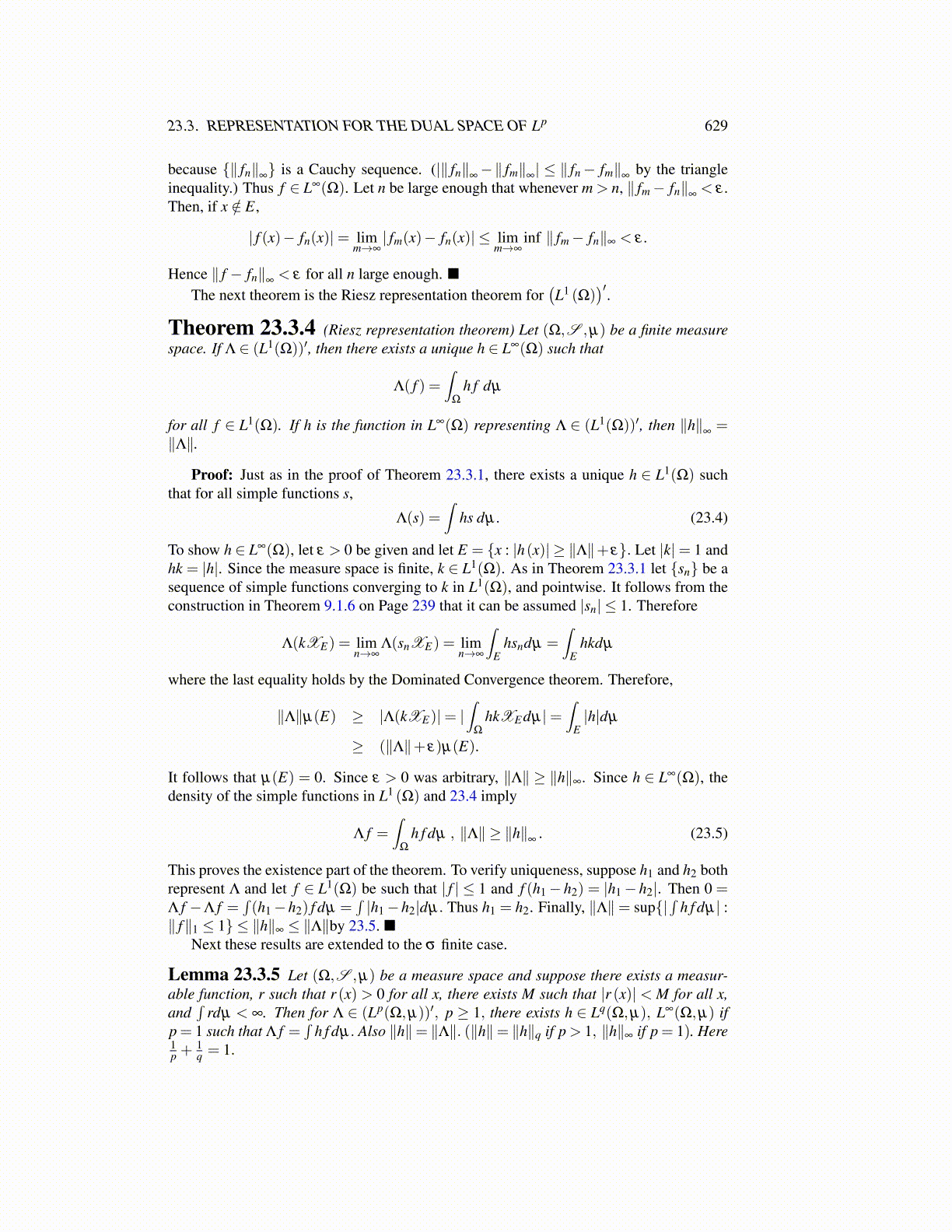
23.3. REPRESENTATION FOR THE DUAL SPACE OF Lp 629
because {∥ fn∥∞} is a Cauchy sequence. (|∥ fn∥∞
−∥ fm∥∞| ≤ ∥ fn− fm∥∞
by the triangleinequality.) Thus f ∈ L∞(Ω). Let n be large enough that whenever m > n, ∥ fm− fn∥∞
< ε .Then, if x /∈ E,
| f (x)− fn(x)|= limm→∞| fm(x)− fn(x)| ≤ lim
m→∞inf ∥ fm− fn∥∞ < ε .
Hence ∥ f − fn∥∞< ε for all n large enough. ■
The next theorem is the Riesz representation theorem for(L1 (Ω)
)′.Theorem 23.3.4 (Riesz representation theorem) Let (Ω,S ,µ) be a finite measurespace. If Λ ∈ (L1(Ω))′, then there exists a unique h ∈ L∞(Ω) such that
Λ( f ) =∫
Ω
h f dµ
for all f ∈ L1(Ω). If h is the function in L∞(Ω) representing Λ ∈ (L1(Ω))′, then ∥h∥∞=
∥Λ∥.
Proof: Just as in the proof of Theorem 23.3.1, there exists a unique h ∈ L1(Ω) suchthat for all simple functions s,
Λ(s) =∫
hs dµ . (23.4)
To show h ∈ L∞(Ω), let ε > 0 be given and let E = {x : |h(x)| ≥ ∥Λ∥+ ε}. Let |k|= 1 andhk = |h|. Since the measure space is finite, k ∈ L1(Ω). As in Theorem 23.3.1 let {sn} be asequence of simple functions converging to k in L1(Ω), and pointwise. It follows from theconstruction in Theorem 9.1.6 on Page 239 that it can be assumed |sn| ≤ 1. Therefore
Λ(kXE) = limn→∞
Λ(snXE) = limn→∞
∫E
hsndµ =∫
Ehkdµ
where the last equality holds by the Dominated Convergence theorem. Therefore,
∥Λ∥µ(E) ≥ |Λ(kXE)|= |∫
Ω
hkXEdµ|=∫
E|h|dµ
≥ (∥Λ∥+ ε)µ(E).
It follows that µ(E) = 0. Since ε > 0 was arbitrary, ∥Λ∥ ≥ ∥h∥∞. Since h ∈ L∞(Ω), thedensity of the simple functions in L1 (Ω) and 23.4 imply
Λ f =∫
Ω
h f dµ , ∥Λ∥ ≥ ∥h∥∞
. (23.5)
This proves the existence part of the theorem. To verify uniqueness, suppose h1 and h2 bothrepresent Λ and let f ∈ L1(Ω) be such that | f | ≤ 1 and f (h1− h2) = |h1− h2|. Then 0 =Λ f −Λ f =
∫(h1−h2) f dµ =
∫|h1−h2|dµ. Thus h1 = h2. Finally, ∥Λ∥= sup{|
∫h f dµ| :
∥ f∥1 ≤ 1} ≤ ∥h∥∞ ≤ ∥Λ∥by 23.5. ■Next these results are extended to the σ finite case.
Lemma 23.3.5 Let (Ω,S ,µ) be a measure space and suppose there exists a measur-able function, r such that r (x) > 0 for all x, there exists M such that |r (x)| < M for all x,and
∫rdµ < ∞. Then for Λ ∈ (Lp(Ω,µ))′, p ≥ 1, there exists h ∈ Lq(Ω,µ), L∞(Ω,µ) if
p = 1 such that Λ f =∫
h f dµ. Also ∥h∥= ∥Λ∥. (∥h∥= ∥h∥q if p > 1, ∥h∥∞ if p = 1). Here1p +
1q = 1.